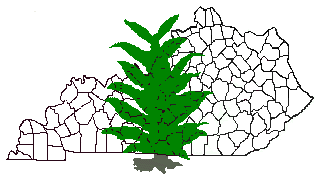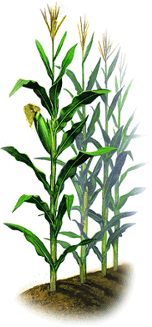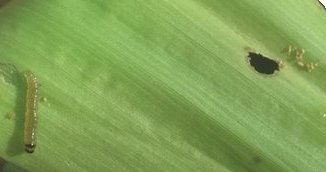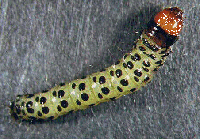

Blue Mold Watch for Wilderness Trail and Quicksand Extension Areas of Kentucky
Blue mold is active in eastern Tennessee in the counties of Grainger (Rutledge) and Sevier (Sevierville). Darrell Hensley reported observing heavy sporulation, local lesions, and systemic infections on samples submitted to his laboratory at the University of Tennessee. Most likely the same weather event that introduced this blue mold into east Tennessee impacted southeastern Kentucky. Moreover, the disease has been present for a while and inoculum generated by these Tennesse outbreaks may have been moved last week or earlier. Therefore, I am posting a Blue Mold Watch for southeastern Kentucky.
During a Watch, controls should be put in place. The following controls are needed in the Watch areas. Preventive fungicide sprays (Ferbam or Dithane) at weekly intervals should be maintained in all transplant production systems to aid in the control of fungal diseases including blue mold. Preventive field applications of fungicides are recommended at this time for sites set with highly susceptible varieties, especially those in rotated land (due to superior growth potential) and foggy sites. Use Acrobat MZ at 2.5 lbs /100 gallons of water, adjusting the concentration and volume of fungicide to the stage of growth, as per the label. Repeat the applications at weekly intervals.
County Blue Mold Coordinators (County Extension Agents for Agriculture) in the Watch areas are urged to check transplant operations (floats, greenhouses, and traditional beds) and fields of rapidly growing tobacco located in foggy bottoms for evidence of the early symptoms and signs of blue mold. I did some scouting of the northern counties in the Watch area on Friday and Sunday, and plan aggressive scouting activities this week. It is important that we find blue mold if it is present, and that we remove counties from the Watch as quickly as possible, if they are not threatened. The key question is: "How widespread is the source?" That question is answered most rapidly through scouting efforts by experienced agents and specialists.
Other Extension Areas of Kentucky - Transplant Traps
As of June 12, blue mold had not been reported in Kentucky. We are aware of no evidence to support that viable blue mold spores may have arrived outside the Watch area of southeastern Kentucky. Moreover, the current hot and dry weather being experienced in most areas of Kentucky is not favorable for blue mold development in natural field situations, except irrigated fields of early-set tobacco that are now closing the canopy. Consequently, the potential for new blue mold development in Kentucky outside the Watch area at this time is very low, assuming the disease has not been introduced with transplants or early via wind. Thus, field fungicide applications are not needed in most of the commonwealth at this time, except for the Watch area.
It is important to eliminate all transplants that are not needed. Overlapping of transplant production and field production is a key factor in blue mold development. Holding transplants is an excellent way to get things started, especially during seasons when the blue mold potential has been very low and the greatest threat comes from airborne inoculum arriving from flue-cured epidemics - just what we are seeing now. Consider the following concerning transplants:
1. Keep all surplus plants sprayed weekly with fungicides - Ferbam or Dithane.
2. Any plants not sprayed within the past 7 days should be destroyed ? killed.
3. Move the surplus transplants to the communities where they are needed, so that the overlap and risk are in the community with the need for plants rather than those without the need.
Southeastern US/Kentucky Connection
Blue mold remains active in the southeastern US, from Florida north into the flue-cured production of eastern North Carolina. As mentioned above, it is now active in burley production of eastern Tennessee. These blue mold outbreaks are a potential threat to Kentucky anytime winds from the southeast area associated with cloud cover blow from the source fields into Kentucky. Because the spores are very sensitive to ultraviolet light, very little risk, if any, exists when there is bright sunlight located anywhere along the route of travel, such as the current situation and the Bermuda High. However, strong haze can develop in Kentucky and stagnate in the southeastern counties, which will protect the fungus from ultraviolet light. Thus, growers and agents should remain in regular (at least twice weekly communication) with the Kentucky Blue Mold Warning System, so that adjustments in the need for controls can be made in a timely manner should they be warranted by the circumstances.
Visit the KY Blue Mold Warning System.
![]() http://www.uky.edu/Agriculture/kpn/kyblue/kyblue.htm
http://www.uky.edu/Agriculture/kpn/kyblue/kyblue.htm

 Reports of European corn borer activity are increasing. Moth flights were moderate over much of the state and window-pane damage is beginning to appear in some fields. Generally, it is thought that the single most important factor that can reduce European corn borer infestations is the occurrence of severe weather during the spring moth flight. Conditions this year during moth flight, mating and egg lying were favorable for this insect. Corn producers should monitor fields for this pest weekly and use the following table to make control decisions.
Reports of European corn borer activity are increasing. Moth flights were moderate over much of the state and window-pane damage is beginning to appear in some fields. Generally, it is thought that the single most important factor that can reduce European corn borer infestations is the occurrence of severe weather during the spring moth flight. Conditions this year during moth flight, mating and egg lying were favorable for this insect. Corn producers should monitor fields for this pest weekly and use the following table to make control decisions.
| Percentage of infested plants | |||||
| 40% | 50% | 60% | 70% | 80% | |
| Early whorl | 4.9 | 6.5 | 8.3 | 10.3 | 12.6 |
| Late whorl | 3.9 | 5.2 | 6.6 | 8.3 | 10.1 |
| Pretassel | 5.9 | 5.2 | 10.0 | 12.4 | 15.0 |
| Pollen shed | 3.9 | 5.2 | 6.6 | 8.3 | 10.1 |
| Kernels initiated | 2.7 | 3.6 | 4.5 | 5.6 | 6.9 |
This table allows the use of (1) % infested plants found by field scouting, (2) anticipated yield from the field (bu/a), (3) crop value ($/bu) and (4) the control cost ($/a for insecticide + application cost) to make control decisions. See ENT-49 for an example using this table.
While all Bt?corn hybrids are highly resistant to attack by the first generation of European corn borer, producers need to monitor these fields, as well as refuge areas.
Southwestern corn borer traps in western KY indicate that there is a moth flight underway in some western counties. Once regarded as the worst insect pest attacking corn in Kentucky, the Southwestern corn borer has been rebounding in the western portion of the state, particularly in counties along the Mississippi River and Ohio River west of Owensboro. While the damage caused by the first generation is very similar to that caused by the European corn borer, fall damage to late planted corn can cause severe lodging and harvest losses. Usually, severe damage by southwestern corn borer is restricted to late planted fields.
 During the next few weeks, producers should monitor their corn for this pest. While damage is similar to European
corn borer, the treatment threshold is lower. An insecticide is recommended for control if 35% of the plants are
infested and live larvae are found in the whorl.
See Insect Management Recommendations
for a list of insecticides recommended for control
of Southwestern corn borer.
During the next few weeks, producers should monitor their corn for this pest. While damage is similar to European
corn borer, the treatment threshold is lower. An insecticide is recommended for control if 35% of the plants are
infested and live larvae are found in the whorl.
See Insect Management Recommendations
for a list of insecticides recommended for control
of Southwestern corn borer.
I and colleagues have received several calls about insects in soybean that might be pests but don't fit the normal
description or are not associated with damage symptoms. It is good to know that so many people are looking so
closely at their crops. However, I ask you to remember two things.
1.) Most of the insects in a soybean field are not pests and
2.) soybeans have a very strong capacity to compensate for damage.
There is no substitution for learning to identify the insects commonly found in fields but too often natural enemies
are mistaken for pests. Sometimes this is because of the difficulty in separating two closely related insects like
the brown stink (pest) and the spined solder bug (predator), but most often is simply a lack of knowledge about
the creatures. When you see damage but not an obvious pest, things are a little more difficult. However,
common pest damage can be very distinctive and indicate to you what you should look for. For example
Bean leaf beetle feeding on leaves is usually composed of very circular holes,
 while worm feeding tends to be
less distinct and the beetles tend to skeletonize soybean leaves. There is no substitution for experience and
training, but as you go along look for large numbers of the same thing.
while worm feeding tends to be
less distinct and the beetles tend to skeletonize soybean leaves. There is no substitution for experience and
training, but as you go along look for large numbers of the same thing.
You can find pictures and information on pests common to Kentucky grown soybean on the IPM web site at: http://www.uky.edu/Agriculture/IPM/ipm.htm . After arriving at this site select "Scout Info On Line". You can also down load PDF versions of the Scout Manuals for various crops.
You can also obtain individual Entfact publications on most crop pests at the Entomology web site for from your County Extension agent.
 A recent Kentucky Pest News article by UK entomologists has indicated that bean leaf beetle populations are larger than normal this spring. This situation has prompted this article since bean leaf beetles are the primary means by which Bean Pod Mottle Virus (BPMV) is transmitted into soybean.
A recent Kentucky Pest News article by UK entomologists has indicated that bean leaf beetle populations are larger than normal this spring. This situation has prompted this article since bean leaf beetles are the primary means by which Bean Pod Mottle Virus (BPMV) is transmitted into soybean.
Previous research by UK plant pathologists has shown that BPMV is extremely common in Kentucky soybean crops. This is a concern for several different reasons. The main one being that the BPMV can significantly impact crop yields. For example, soybean yield losses of 10-55% have been reported as a consequence of BPMV infection. Greater yield loss tends to occur the younger the plants are when infected. Where BPMV occurs in plants also infected with another very common seed and aphid transmitted virus, Soybean Mosaic Virus (SMV), yield losses in plants can exceed 55%. Another reason we are concerned about the increased potential for BPMV this season is that plants infected by the virus tend to have higher levels of Phomopsis seed infection. This is a serious seed quality concern for anyone producing soybean for seed. Finally, we have recently seen an increase in a "severe strain" of BPMV which may have the potential to reduce crop yields to a greater extent than the "normal" strain.
Kentucky is not alone in its concern about the apparent increase in BPMV generally, and the severe strain of BPMV, specifically. In fact, I am aware that plant pathologists and farmers in the North Central and Great Plains states are becoming increasingly alarmed at the upswing in BPMV incidence and severity. This trend has made BPMV a hot topic at various producer and scientific meetings in those regions. Dr S. A. Ghabrial, a virologist in the U K Department of Plant Pathology, is one of the very few individuals in the world doing any significant amount of work on BPMV. As a consequence, he has been heavily involved recently in providing information to various professionals and associations as well as making presentations at various meetings.
One of the major areas of BPMV research with little study is virus survival during winter and in virus reservoirs. Viruses, generally, must survive during winter in either seed, live plants or a vector (e.g., insect) in order to successfully spread to healthy young plants the following season. Research from Dr. Ghabrial's laboratory has shown that neither seed nor overwintering bean leaf beetles are important for BPMV survival. In the past, efforts have been attempted to find a weed host which may serve as a reservoir for the virus. However, to date nothing of any consequence has surfaced. Additional work this summer will focus on other possible aspects of early spread of BPMV into and within young soybean crops.
In the future, the primary means of managing BPMV in soybean may be with the use of resistant soybean varieties. Presently, this option does not exist to farmers since all soybean varieties are susceptible to BPMV infection. However, transgenic soybean lines that exhibit moderate to high resistance to BPMV infection are available in Dr. Ghabrial's laboratory and are currently being tested under field conditions. This may lead to a practical method of BPMV control in the future.
![]() As the harvest season ends, some strawberries in Kentucky are showing symptoms of strawberry leaf spot diseases. Strawberry leaf spot, caused by the fungus Mycosphaerella fragariae, is the most common of these diseases followed by strawberry leaf blight (Phomopsis obscurans) and strawberry leaf scorch (Diplocarpon earliana). A bacterial leaf spot, called angular leaf spot (Xanthomonas fragariae), occurs in Kentucky, but it is relatively uncommon. Growing seasons with cool, moist weather could favor angular leaf spot. If leaf diseases build to high levels, plants become weakened and often yield poorly the next year.
As the harvest season ends, some strawberries in Kentucky are showing symptoms of strawberry leaf spot diseases. Strawberry leaf spot, caused by the fungus Mycosphaerella fragariae, is the most common of these diseases followed by strawberry leaf blight (Phomopsis obscurans) and strawberry leaf scorch (Diplocarpon earliana). A bacterial leaf spot, called angular leaf spot (Xanthomonas fragariae), occurs in Kentucky, but it is relatively uncommon. Growing seasons with cool, moist weather could favor angular leaf spot. If leaf diseases build to high levels, plants become weakened and often yield poorly the next year.
Symptoms. Strawberry leaf spot starts out as small purple spots which enlarge to form purple spots with light tan centers, usually less than 1/4 inch across. Leaf blight starts out as small purple spots, but quickly enlarges to much larger irregular or "v" shaped spots with concentric dark and light brown rings on the edge of the spot. As adjacent spots coalesce, the entire leaf may become blighted. Leaf scorch disease is characterized by numerous tiny purple spots which do not develop tan centers, but may develop dark brown centers. When these spots are numerous, the leaf my dry up and appear scorched. Bacterial spot infections produce angular spots delimited by small leaf veins. These spots may at first appear to be water soaked, and sometimes show viscous bacterial exudate on the leaf undersides.
Spread. The pathogens causing strawberry leaf spots overwinter on infected or dead leaves from the previous year. Spores or bacterial cells produced in the diseased spots are spread to healthy leaves in splashing water. The scorch and leaf spot fungi may also produce special spores that are carried by air currents from overwintering sources of the fungus to healthy plants. The fungal leaf spots are most active at temperatures in the range of 65-75 degrees while bacterial leaf spot is active at cooler temperatures. Leaf spot diseases are more severe when there are prolonged rainy periods following harvest.
Control. Growers of leaf spot susceptible strawberries should consider fungicide sprays throughout the summer, especially during rainy periods. Fungicides such as captan, thiram, benomyl (Benlate), or thiophanate-methyl (Topsin-M) are all effective for fungal leaf spot diseases. To prevent fungicide resistance from developing, avoid using benomyl or thiophanate-methyl as the only fungicide throughout the season. Mix or alternate with captan or thiram.
Strawberry growers with varieties such as Delite, Earliglow, Marlate, Ozark Beauty, and Surecrop should not have to spray as much for leaf spot diseases, because these varieties are more tolerant to leaf spots. However, growers with susceptible strawberries such as Guardian, Midway, Raritan, Redchief, and Redglow should consider a preventive spray schedule. Sprays for varieties not listed should be made based on how much leaf spot was observed last season just after harvest.

Dow AgroSciences and the U.S. Environmental Protection Agency (EPA) reached an agreement last week that will eventually eliminate all uses of chlorpyrifos (DursbanTM) insecticides in and around residential structures. This is the most significant and far-reaching ruling on a household pest control product since the withdrawal of chlordane in the late 1980's.
Reasons for Withdrawal - Under the Food Quality Protection Act of 1996, EPA has begun to reevaluate all pesticide uses in order to reduce exposures, particularly to children. Dursban is one of the first products to undergo EPA's pesticide reassessment utilizing safety standards far more stringent than those in the past. There is considerable debate within the scientific community whether the newly-imposed safety factors are "appropriate" and whether current usage patterns are really of any risk to humans. In order to retain some of the more lucrative agricultural uses of chlorpyrifos (LorsbanTM), Dow AgroSciences voluntarily agreed to give up most uses of the product, in-and-around homes.
What Will be the Impact?- Dursban is one of the most widely used household insecticides for control of termites,
ants, cockroaches fleas, spiders, ticks, crickets, etc. Professional pest control firms have used chlorpyrifos
(the active ingredient in Dursban) for more than 30 years, and it is one of the most common ingredients
in household and lawn and garden insecticides purchased over-the-counter. Significant terms of the agreement
include:
- Cancellation of all future termite control uses on existing structures, once existing supplies are depleted.
Preventive termite treatment of new construction (pre-treatments) will be permitted until 2005.
Cancellation of all retail household and lawn & garden sales of chlorpyrifos products after December 31, 2001.
Many of the current crop uses have been retained, as have certain nonresidential (professional) uses, such as on
golf courses and in greenhouses.
What are the Alternatives? - The professional pest control industry will be affected by these changes, but for the most part will have effective alternatives. For termite control, several products containing synthetic pyrethroids as active ingredients (e.g., DragnetTM, PreludeTM, DemonTM, TalstarTM) continue to be available, and two newer products - PremiseTM (imidacloprid) and just-introduced TermidorTM (fipronil) - are performing exceptionally well.
The most far-ranging effect of the new ruling will likely be on householders ("do-it-yourselfers"). Chlorpyrifos is the principal active ingredient in hundreds of home pest control products sold over-the-counter in the form of "all-purpose" insect sprays, granules, and flea control collars. Most of the other insecticides widely sold in retail stores contain diazinon (another insecticide under EPA scrutiny), and Sevin which is primarily for outdoor use.
A small number of do-it-yourself products, e.g., Spectracide Bug StopTM, Ortho Home Defense SystemTM, Bayer Advanced Home/Lawn & Garden Insect Killer contain synthetic pyrethroids as active ingredients. You may want to mention these products to householders seeking a spray alternative to Dursban. The growing arsenal of bait formulations (e.g., CombatTM, RaidTM, TerroTM Ant Killer II) generally are materials of choice for cockroach and ant control.
Clients who are concerned about potential health risks of Dursban, such as those who recently had their home treated for termites, should be referred either to Dow AgroSciences (1-800-369-4352; www.chlorpyrifos.com) or to the local pest control firm that performed the treatment. In their recent ruling, EPA has noted that there are no imminent health risks associated with chlorpyrifos, which is why they have allowed continued use of the product until existing supplies are depleted.

Samples in the diagnostic lab last week included zinc deficiency and Pythium root rot (seedling) on corn; Pythium root rot and Lepto leaf spot on alfalfa; brown stripe (Cercosporidium) on orchardgrass; and glume blotch on wheat. On tobacco, we have seen target spot, black shank, black root rot, bacterial blackleg, angular leaf spot, tomato spotted wilt virus, tobacco streak virus, tobacco ringspot virus, transplant shock, temporary phosphorus deficiency, manganese toxicity, and herbicide injury. On turfgrasses, we have seen Rhizoctonia crown rot on bermudagrass; rust on bluegrass and ryegrass; anthracnose on fescue; and large patch (Rhizoctonia) on zoysiagrass. On woody landscape plants, we have seen Verticillium wilt and anthracnose on maple; powdery mildew on barberry and rose; Discula anthracnose on dogwood; and leaf/flower gall on azalea.
On vegetables, we have seen bacterial spot and speck, leaf mold (Cladosporium) and Septoria leaf spot on tomato; and bacterial wilt on squash.

| UKREC-Princeton, KY, Jun 2 - 9, 2000 | |
| Black Cutworm | 2 |
| True Armyworm | 73 |
| Corn Earworm | 8 |
| European Corn Borer | 0 |
| Southwestern Corn Borer | 37 |
Arborists, landscape managers, County Extension Agents, and others working in the Kentucky landscape industry can improve their skills in dealing with problem plants and plant problems in the landscape. On Friday June 9, landscape industry professionals and Cooperative Extension Agents will have an opportunity to attend one of two workshops that will address tree problems or problem trees.
Hazard Tree Workshop in Bowling Green June 9, 8:00 a.m. to 4:30 p.m CDT.
Why a hazard tree workshop? Landscape
professionals can sometimes be held liable for failing
to recognize or take action on hazard trees in the
landscape of their clients. The purpose of this
workshop is to aid professional arborists and
landscape managers in predicting which trees have an
increased risk of falling and causing damage to
property and life. The workshop, which includes
field exercises covers such topics as diagnostic tools,
tree, target, and site characteristics, disease defects,
hazard ratings, legal ramifications, wood strength
loss, and mitigating hazards. This hands-on short
course is designed for both beginning and
experienced professionals.
Additional information/questions. Contact Dr. Bill Fountain, U.K. Department of Horticulture by telephone (859) 257-3320, by fax (859) 257-2859, or by e-mail wfountain@ca.uky.edu wfountain@ca.uky.edu. A registration fee which covers lunch and workshop supplies will be charged and enrollment is limited, so contact Dr. Fountain immediately. The workshop is jointly sponsored by the Kentucky Cooperative Extension Service, International Society of Arboriculture, and Kentucky Arborists Association and will be held at Basil-Griffin Park in Bowling Green.
Plant Diagnostic Workshop in Boone County June 9, 10:00 a.m. to 4:00 p.m.
Diagnose disease and insect problems of woody plants. This is a chance for landscape professionals and Extension personnel to brush up on their plant problem diagnostic skills. The 32nd Plant Diagnostic Workshop will involve landscape professionals and Cooperative Extension Agents from Kentucky, Ohio, and Indiana. The workshop begins at the Boone County Extension Office and will feature sessions on disease and insect-caused galls of landscape plants and plant disease and insect updates followed by field observations at the Boone County Arboretum.
Additional information/questions. There will be a registration fee of $10 to cover lunch and supplies. For more information and directions to the workshop, contact Mike Klahr, Boone County Extension Agent for Horticulture by telephone (859) 586-6101, fax (859) 586-6107, or by e-mail mklahr@ca.uky.edu mklahr@ca.uky.edu.

Lee Townsend
Extension Entomologist